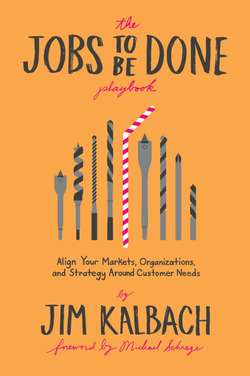Читать книгу The Jobs To Be Done Playbook - Jim Kalbach - Страница 37
На сайте Литреса книга снята с продажи.
ОглавлениеCHAPTER 3 Discovering Value
IN THIS CHAPTER, YOU WILL LEARN ABOUT THESE PLAYS:
• Two interviewing approaches: Jobs interviews and Switch interviews
• Analyzing insights with the Four Forces techniques
• How to map a job
I’m lucky. I regularly speak with customers. It’s a privilege to observe people in their natural settings and to be able to see the world from their perspective. I thrive on it.
But few people in an organization get that chance. Think about it: How many people in your company have never spoken with a customer? As a result, a lot of misguided assumptions are made about what people will actually find valuable. Teams don’t agree on how customer insight informs their efforts and ultimately informs growth.
It’s up to you to bring market insight back to your organization. Long research reports don’t work: people don’t read them. If not made actionable, study findings get forgotten and have no impact.
JTBD changes things. It focuses on a clear unit of analysis: the job. This, in turn, serves as an axis for decision-making across the organization. More importantly, JTBD gives a consistent language to align around. You not only can agree that understanding customer needs are important, but also how to express and act on those needs consistently.
This isn’t to say that organizations should stop other types of investigation and discovery. Surveys help understand satisfaction, usability tests improve products, and on-site visits deepen empathy. Keep doing these things.
But when done effectively, JTBD serves as a core engine of inquiry that yields long-lasting models, which can be used to drive roadmaps for years. It feeds innovation with raw materials and insights from customer discovery.
This chapter presents techniques for discovering and making sense of jobs. First, you’ll have to engage people in research, primarily in the form of interview. Then you can analyze the forces of demand generation and map out the job process to make sense of your insights. Use these opportunities to get people from your organization to engage and interact with customers. The alignment of perspectives you can gain from fundamental discovery activities is invaluable later during solution-finding phases.
PLAY Conduct Jobs Interviews
Jobs don’t come in neat, little packages. You have to hunt for them. You won’t find jobs from analytics or marketing surveys, and you can’t just “brainstorm” jobs and needs. You have to get out and talk to job performers in formal interviews.
Start by getting the right people—job performers. Then lead an open interview that lets them speak in their own words about their objectives. Don’t read from a questionnaire, but instead probe on the job process and needs. Afterward, you’ll need to translate what you heard into the JTBD language.
Note that jobs interviews are not intended for gaining empathy for participants per se, although that is often inevitable. Critics point out that jobs interviews miss a lot of the details about the person’s overall experience. Jobs interviews also don’t get at psychological states, even if there are questions about emotions and social aspects. Instead, the JTBD approach assumes that people are first and foremost motivated to get the job done so they can make progress. The interviews favor a more surgical approach to reach their goals and needs.
